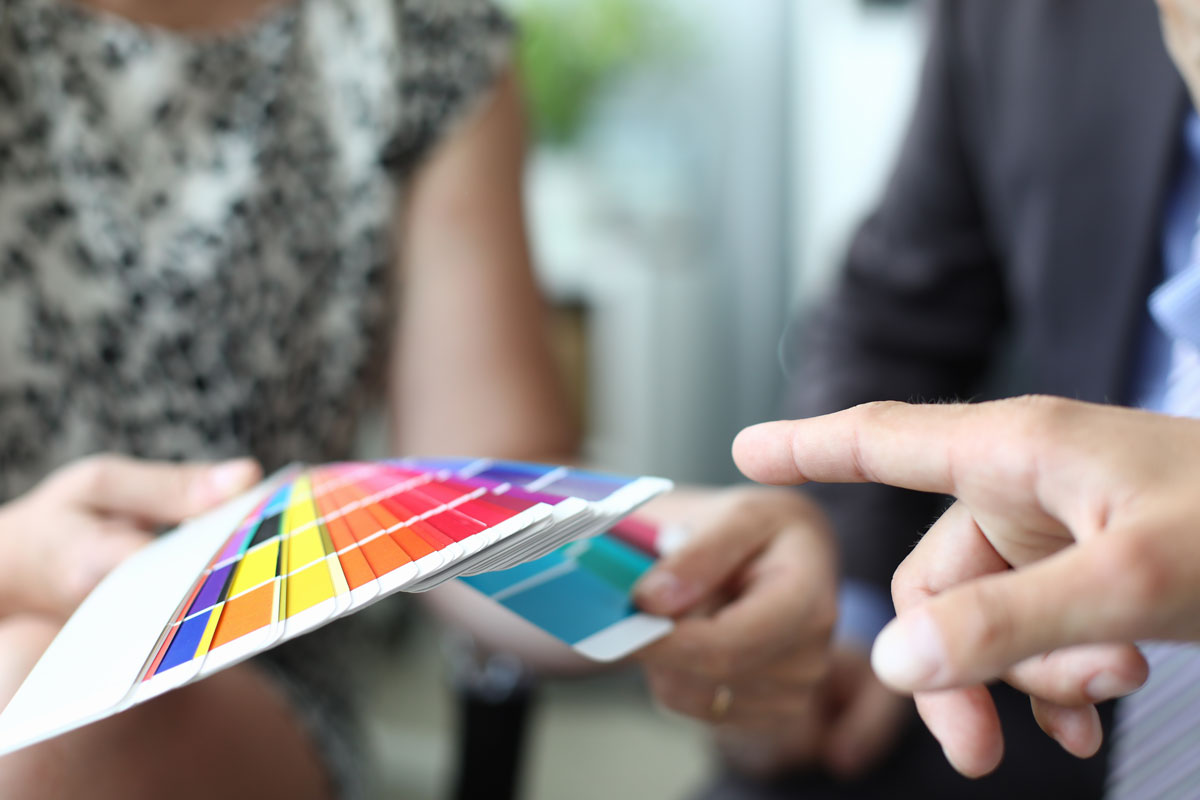Hey there, fellow web enthusiasts! Are you prepared to go off on a vibrant web design journey? Today, we're diving deep into the captivating world of website color schemes. If you are an experienced designer, or even if you are just beginning, gaining knowledge about color palettes is essential. Learning about the subtle differences can improve your website's look and efficiency. Understanding how colors affect a user's experience can also enhance the effectiveness of your site. Let's get ready and dive into the art of choosing the best website color schemes. We aim to select colors that will truly impress your audience.
Unveiling the Power of Color
Colors aren't just visual elements but potent tools that can evoke emotions, convey messages, and even influence decisions. Imagine stepping into a room awash with calming blues versus one bursting with vibrant reds. The psychological impact is undeniable. Similarly, when users land on your website, your chosen color scheme sets the tone for their entire experience.
Why Do Color Schemes Matter?
Colors communicate subconsciously, affecting how users perceive your brand and content. Research shows that color influences up to 90% of quick product decisions. When it comes to websites, color schemes play a pivotal role in the following:
-
First Impressions: The right color palette for your website can make a big difference. It creates the first impression that can attract or repel visitors. A welcoming color scheme keeps viewers interested and engaged with your content.
Branding: Colors play a crucial role in defining your brand identity. Using the same colors consistently helps to build recognition and trust gradually.
User Engagement: Selecting the appropriate color combinations can navigate users to crucial elements and prompt them to take certain actions.
Readability: The color contrast between your text and background significantly affects how easy it is to read your content.
-
Emotional Connection: Acknowledging how different colors can stir various emotions is important. Bright and warm tones such as red and orange are known for sparking a sense of excitement. On the other hand, cooler hues like blue and green tend to bring out feelings of calmness.
Decoding Color Harmony: Aesthetic Color Schemes
When creating a visually appealing website, understanding color harmony is crucial. Color harmony refers to the art of combining colors to create a balanced and pleasing visual experience for your audience. Choosing the right color scheme can communicate your brand's personality, evoke emotions, and guide user interaction.
1. Monochromatic Color Scheme
Imagine a painter using different shades of blue to create a serene seascape. The monochromatic color scheme follows a similar concept. It involves using variations of a single color to create a sophisticated and unified look.
This scheme is perfect for minimalist designs and projects an air of simplicity and elegance. You can add depth and dimension to your website by playing with different tones and shades.
Apple: Apple's website typically uses a monochromatic color scheme. This means it focuses on clean lines and shades of just one color. This approach gives the site a modern and classy appearance.
2. Analogous Color Scheme
Think of analogous colors as best friends on the color wheel. These colors are located next to each other and share similar undertones. When used together, they create a sense of harmony and cohesion. This scheme is excellent for evoking specific moods.
For example, using shades of green and blue can give a feeling of peace and nature. On the other hand, combining warm yellows and oranges can create a sense of warmth and energy.
Spotify: Spotify uses shades of green and blue, comparable colors. This design gives a unified, relaxing feel that fits their music-focused brand image.
3. Complementary Color Scheme
Remember the phrase "opposites attract"? That's the essence of the complementary color scheme. Colors that sit directly across each other on the color wheel are complementary pairs. When combined, they create a high contrast and draw immediate attention.
This scheme works great in making a visual impact. It can be used strategically, too. You can highlight important elements with it, like call-to-action buttons or headlines.
Netflix: Netflix uses a vibrant red hue in its logo against a deep black background. This generates an attractive contrasting color combination, captivating our attention and projecting vitality.
4. Triadic Color Scheme
Consider the triadic color scheme if you want to add vibrancy to your website. This scheme involves selecting three evenly spaced colors around the color wheel. The result is a balanced, dynamic palette that captures attention without overwhelming the viewer. Properly executed, a triadic color scheme can create a playful and engaging atmosphere.
Google: Google uses primary colors - red, blue, and yellow. These form a triadic color scheme that symbolizes their innovative and playful brand identity.
5. Split-Complementary Color Scheme
A split-complementary color scheme is a variant of the complementary scheme. It works by using a base color, along with the two colors that lie next to its complementary color. This provides a similar contrast while introducing more variety and subtlety. It balances vibrancy and harmony, making it suitable for websites that want to convey energy and cohesion.
Understanding these aesthetic color schemes gives you the tools to craft visually pleasing websites that resonate with your audience.
Dropbox: Dropbox employs a base color of blue, paired with the adjacent colors of yellow and orange. This split-complementary scheme enhances their user-friendly and approachable image.
Crafting a Captivating Color Palette
Creating a captivating color palette isn't just about selecting beautiful colors that look good together. It's about crafting a visual language that resonates with your brand, communicates your message, and enhances user experience. Here's how you can master the art of color palette creation:
1. Understand Your Brand
Before you dive into colors, understand your brand's personality and values. Are you a playful, youthful, sophisticated, and professional brand? The colors you choose should align with your brand's identity. For example, a tech startup might opt for bold and modern colors, while a wellness blog might lean towards soothing and natural tones.
2. Consider Color Meanings
Colors come with built-in meanings and associations. Red often symbolizes passion and excitement, while blue represents trust and tranquility. Research the psychology behind colors and choose ones that resonate with the emotions you want to evoke in your audience. Remember that these meanings can be culturally influenced, so consider your target audience's cultural background.
3. Create Contrast for Readability
A captivating color palette isn't just about aesthetics – it's also about usability. Readability is ensured by a stark contrast between the text and backdrop colors. Dark text on a light background or vice versa is a safe bet for legibility. Remember, your website's content needs to be easily digestible by all users, regardless of their device or screen settings.
4. Limit Your Color Palette
Incorporating every color under the sun is tempting, but too many colors can overwhelm your audience. Stick to a limited color palette, typically three to five primary colors. This maintains visual consistency and helps users associate specific colors with your brand. The chosen colors should also work well in various contexts, from your website to marketing materials.
5. Test Accessibility
Around 4.5% of the world's population has color vision deficiencies. Ensure your color choices don't hinder these users' experience. Use online tools to assess your palette's accessibility.
Setting the Right Accent: The Role of Accent Colors
Accent colors are like the cherry on top of your color palette sundae. They add a pop of vibrancy and guide users' attention to key elements.
Think of accent colors as the spotlight on the stage. They draw eyes to your call-to-action buttons, important headings, and clickable links. This visual hierarchy enhances user experience by making navigation intuitive.
Weaving the Magic: Color Combinations That Work
Selecting the right color combination is like creating a symphony of visual elements that resonate with your audience. When colors harmonize, they can evoke emotions, establish brand identity, and guide user interaction. Here are some tried-and-true color combinations that work like magic:
1. Blue and White: Timeless Elegance
Imagine a clear blue sky against the backdrop of white clouds. The blue and white color combination offers a timeless and elegant look. Blue signifies trust and tranquility, making users feel at ease, while white imparts simplicity and cleanliness. Corporate and tech brands often use this pairing to create a professional and approachable image.
Facebook: Facebook's iconic blue and white color combination evokes trust and reliability, making users feel at ease when navigating their platform.
Image by Freepik
2. Green and Brown: Natural Appeal
Picture a lush forest floor with earthy brown tones and vibrant green foliage. The green and brown combination creates a natural and organic feel. Green symbolizes growth, health, and nature, while brown adds warmth and stability. This palette is popular among eco-friendly brands and those that emphasize sustainability.
Patagonia: The well-known outdoor brand, Patagonia, uses green and brown shades in its website design. Why? This is to match with their focus on nature. They aim to create a feeling of connection with the environment through their colors.
https://www.patagonia.com/home/
3. Black, Red, and White: Bold and Striking
Visualize a red rose against a black and white photograph. The combination of black, red, and white creates a bold and striking contrast. Black adds depth and sophistication, red exudes energy and passion, and white maintains balance. Brands often use this combination to make a strong and memorable statement.
Spline: The Spline website uses a powerful mix of black, red, and white colors. These bold colors help to emphasize their energetic brand image.
4. Pastels: Soft and Subtle
Think of delicate pastel shades like a soft sunrise painting the sky. Pastel colors like light pink, mint green, and pale blue create a gentle and soothing ambiance. This combination is perfect for beauty, wellness, and lifestyle brands, conveying a sense of calm and friendliness.
Sephora: Sephora's website often incorporates pastel colors to create a soft and welcoming atmosphere, in line with their beauty and wellness products.
5. Orange and Gray: Modern Energy
Imagine a vibrant sunset against a city skyline. The orange and gray combination exudes modernity and energy. Orange represents enthusiasm and creativity, while gray adds a touch of sophistication. Technology and lifestyle brands often use this palette to communicate innovation and vitality.
Sketch: Sketch's combination of orange and gray creates a modern and energetic vibe, reflecting their athletic and dynamic brand identity.
These color combinations are just a starting point. Remember, the effectiveness of a color palette depends on how well it aligns with your brand's identity, message, and target audience. If you want your website to have a classic and elegant look or a bold and energetic vibe, choosing the right color combination is essential. It sets the tone for the overall experience on your website.
The Final Brushstroke: Perfecting Your Website's Color Scheme
Congratulations! You're now armed with the knowledge to craft an unforgettable website color scheme. Remember, your color palette should reflect your brand's personality, resonate with your target audience, and enhance user experience. So, don't be afraid to experiment, but always keep your users' needs in mind.
In the vibrant sphere of web design, choosing the right color scheme is more than just a feast for the eyes. It's an essential strategic tool. Not only does it shape how your website is perceived, but it also encourages user engagement.
So go ahead, pick up your virtual paintbrush, and start creating your digital masterpiece with the perfect palette of colors!
FAQs About Website Color Schemes
1. Are there specific colors that universally evoke certain emotions?
Absolutely! Colors have psychological associations. For instance, blue conveys trust and calmness, while red evokes energy and passion. However, cultural context can influence these associations.
2. Can I use more than three colors in my color palette?
While there's no strict rule, sticking to three primary colors is recommended to maintain visual consistency. Additional shades can be used as needed for accents.
3. How can I ensure my chosen color scheme is accessible to all users?
Online tools like color contrast checkers can help you evaluate the accessibility of your color choices. Aim for a clear contrast between text and background colors.
4. Can I change my color scheme in the future?
Absolutely! As your brand evolves, you might want to refresh your color palette. Just ensure that the new scheme aligns with your brand identity.




